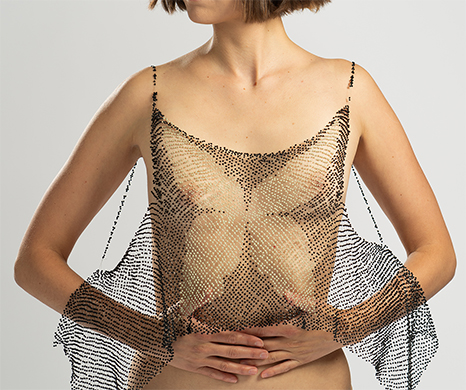This story is part of Next Generation, a series in which we give young makers a platform to showcase their work. Your work here? Get in touch and plot your coordinates as we navigate our future together.
Aradhita Parasrampuria is a sustainable materials researcher and textile designer originally from India, based in New York. Aradhita creates scientific, eco-friendly, ethical, and affordable textiles to help replace toxic petroleum-based products. She works primarily with organisms such as algae, escherichia coli, and mycelium. She is the recipient of the Aronson Fellowship from Tishman Environment and Design Center. Her work has been featured in Vogue, L'officiel Brazil, CFDA, No-Kill Magazine, New York Design Week, Mana Contemporary, and Talking Textiles. She recently graduated from the MFA Textiles program at Parsons School of Design with the project Bio Embellishments.

Aradhita Parasrampuria has created this collection of pieces utilizing biodegradable algae-based embellishments that transform with their environment, in order to challenge the separation between artificial materials and the biological world. The heart of this body of work are beads created using an algae biopolymer solution that is water-resistant, antimicrobial, and self-replenishing. Parasrampuria weaves the beads into intricate textiles using a beadwork technique she developed. The embellishments react with sunlight to change color or glow in the dark, creating an interactive experience for the user.
She designed this function to encourage people to create a bond with the material and help consumers see the beads as living, breathing organisms that must be preserved and cared for instead of used and disposed.

Parasrampuria works with a protein isolated from jellyfish to make her beads bioluminescent. She designed this function to encourage people to create a bond with the material and help consumers see the beads as living, breathing organisms that must be preserved and cared for instead of used and disposed. The beads are dyed using non-toxic microbial pigments.

The embellishment industry relies on petroleum plastic and synthetic resins to create beaded products, leading to waste and microplastics. Parasrampuria’s aim is to create circular design systems that utilize renewable resources. Algae beads offer a viable solution as they are biodegradable and non toxic. With materials like these, a future where the embellishment and fashion industry operates in a closed-loop product life cycle could potentially become a reality.


Share your thoughts and join the technology debate!
Be the first to comment